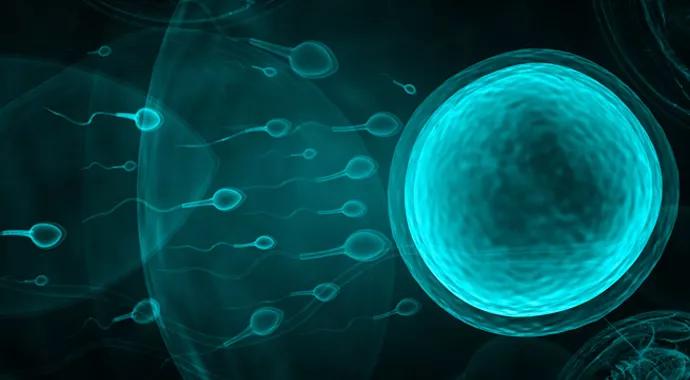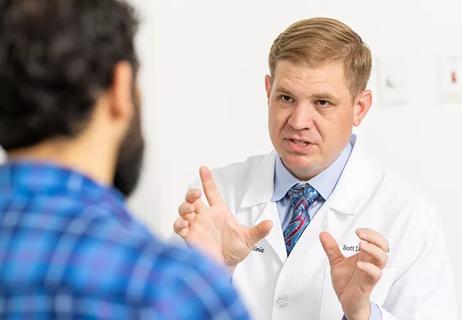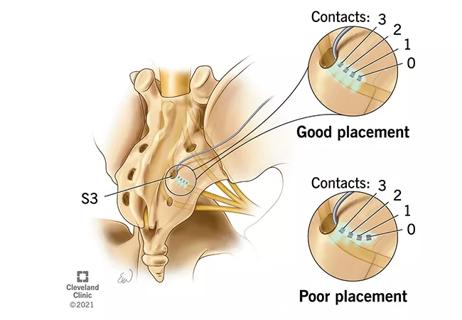Proteomic analysis could enable targeted male infertility treatment

By Edmund Sabanegh Jr., MD, and Ashok Agarwal, PhD
Cleveland Clinic is a non-profit academic medical center. Advertising on our site helps support our mission. We do not endorse non-Cleveland Clinic products or services. Policy
Up to 15 percent of couples are infertile, with almost 50 percent of those having male factor as a contributing cause. For the past 50 years, semen analysis has been the mainstay of the male fertility evaluation.1
Although advances in semen testing have incorporated computer-assisted technologies, the test has remained fundamentally unchanged, with emphasis on the three main parameters: sperm count, motility and morphology. The most significant modifications have involved the redefinition of normal ranges of semen parameters as defined in five iterations of the World Health Organization’s reference values, most recently in 2010.2
Despite these updates, clinicians and patients remain frustrated with the low sensitivity and specificity of the conventional semen analysis. Many men with abnormal semen parameters will go on to achieve spontaneous pregnancies, and less than 50 percent of infertile men have a discernible etiology. The remarkable day-to-day and geographic variability in ejaculate quality further limits test utility.
It is against this backdrop that our team has been working on new tests to assess sperm function. With the development of tests including sperm DNA fragmentation3 and oxidative stress assessments,4 we have improved our ability to critically examine sperm function. New studies in sperm proteomics show that proteomic analysis holds exciting promise that will allow targeted treatments for male infertility.5-9
Proteomics involves careful analysis of proteins expressed by a cell or tissue. The study of protein expression has been the subject of intense research for many diseases during the past decade, with much interest devoted to reproductive implications. At present, more than 6,000 discrete proteins have been identified in semen, which represents about three quarters of the entire sperm proteome.
Our work has demonstrated differential protein expression over controls in a variety of situations that include idiopathic male infertility, varicocele, azoospermia and assisted reproductive technology failure. This early work allows the development of methods to study male infertility, which was previously believed to be idiopathic, and ultimately to stratify interventions based on laboratory results.10,11
Although previous studies have examined altered protein profiles in varicocele patients compared with normal fertile men, there are no proteomic studies comparing the etiology of fertile men with that of infertile men with bilateral varicocele.
In a recent study, we examined how the etiology of bilateral varicocele-related male infertility might be affected by the differential expression of key proteins in spermatozoa that results in testicular dysfunction and impairment of male fertility potential. We also validated two differentially expressed proteins (DEPs) that have reproductive function. We examined the DEPs extracted from spermatozoa cells from patients with bilateral varicocele (N = 17) and healthy donors (N = 10).
Using genomewide profiling, we found more than 1,000 proteins in the fertile group and a similar number in the group with bilateral varicocele. We identified 73 DEPs, of which seven were unique to the bilateral group and 58 were differentially expressed (overexpressed or underexpressed) in either group (Figure 1A). Proteins were further classified according to their abundance (high, medium, low and very low) (Figures 1B and C). The abundance (both high and medium) of proteins observed in the group with bilateral varicocele again demonstrates their likely involvement in the etiology of the disease.

Figure 1. (A) Venn diagram of differentially expressed proteins (DEPs). Eight proteins are uniquely expressed in the fertile control group, seven proteins are uniquely expressed in the bilateral varicocele group and 58 proteins are commonly expressed in both groups. (B) Protein abundance of DEPs that are overexpressed, underexpressed or uniquely expressed in the fertile control group versus bilateral varicocele group. (C) Comparison of high, medium, low or very low abundance of DEPs in fertile controls and men with bilateral varicocele based on the normalized spectral counts obtained from the proteomic profile and gene ontology annotations for DEPs. H = high M = moderate L = low VL = very low
We have demonstrated for the first time the presence of DEPs and identified proteins with distinct reproductive functions that are affected in infertile men with bilateral varicocele. The majority of the DEPs were associated with metabolic processes, stress responses, oxidoreductase activity, enzyme regulation and immune system processes. The topmost network with the core function of lipid metabolism showed five overexpressed and seven underexpressed DEPs in bilateral varicocele samples. Seven DEPs were involved in sperm function such as capacitation, motility and zona-egg binding. Two proteins, Tektin-3 (TEKT3) and T-complex protein 11 homolog (TCP11), may serve as potential biomarkers for bilateral varicocele.
Additional proteomic analysis identified 12 DEPs annotated with distinct functional categories. Of these, seven were related to reproduction and/or spermatogenesis, including sperm tail filaments, sperm motility, sperm function and binding of sperm to zona pellucida.
Of the seven proteins involved in reproductive-related functions, four proteins were overexpressed in the bilateral varicocele group. These were outer dense fibers protein 2 (ODF2), TEKT3, TCP11 and protein-glutamine gamma-glutamyltransferase 4 (TGM4). Calmegin (CLGN) and mitochondrial import receptor subunit TOM22 homolog (TOM22) were underexpressed in the group with bilateral varicocele. Apolipoprotein A1 was unique to the fertile group only. The details of the gene name, protein name and spermatogenic function of the DEPs in the group with bilateral varicocele compared with the fertile control group are shown in Table 1.

Table 1. Gene name, protein name and spermatogenic function of the DEPs in the group with bilateral varicocele compared with the fertile control group.
For the first time, we have demonstrated significantly poorer sperm morphology and elevated levels of reactive oxygen species in men with bilateral varicocele. These abnormalities also translate into significant alteration and overexpression of DEPs ODF2, TEKT3, TCP11 and TGM4. In addition, men with bilateral varicocele had underexpression of CLGN and TOM22, which may be responsible for the severity of the disease and sperm dysfunction in these patients.
These DEPs may serve as useful biomarkers in the identification of bilateral varicocele and in helping urologists identify better options for clinical management of infertile men with bilateral varicocele.
While we continue to rely on conventional semen parameters in the evaluation of the subfertile male, proteomic analysis holds great promise as a diagnostic tool in the reproductive medicine armamentarium. With the identification of novel biomarkers through proteomic studies, clinical tests and treatments for sperm dysfunction may be developed to potentially help infertile couples.
Dr. Sabanegh is Chairman of Cleveland Clinic Glickman Urological & Kidney Institute’s Department of Urology. Dr. Agarwal is Director of the Department of Urology’s Center for Reproductive Medicine and the Andrology Center.

Review the advantages and disadvantages of newer interventions

Pioneering and refining the approach in pyeloplasty, nephrectomy and more

Unlike earlier pills, new drugs do not cause liver toxicity

Male factors play a role in about half of all infertility cases, yet men often are not evaluated

Hadley Wood, MD, shares her vision as the new editor-in-chief of Urology

Study leverages data from the ROSETTA trial

More on the procedure and the institutional experience

Explain some, but not all, of lower utilization